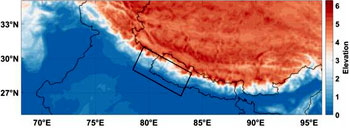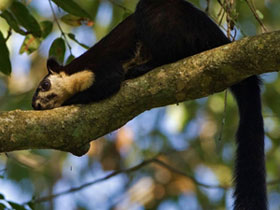December 2020 Environment
Sakshi Education
- ‘World’s ugliest orchid’ among new species named in 2020
 Gastrodia Agnicellus, a newly discovered orchid has been named “the ugliest orchid in the world.”
Gastrodia Agnicellus, a newly discovered orchid has been named “the ugliest orchid in the world.”
It is found in a forest in Madagascar.
The orchid depends on fungi for nutrition and has no leaves or any other photosynthetic tissue.
Although assessed as a threatened species, the plants have some protection because they are located in a national park.
Madagascar is an island country in the Indian Ocean, approximately 400 kilometers off the coast of East Africa. Madagascar is the world's second-largest island country.
- First-of-its-kind monkey rescue centre opened near Chincholi village in Telangana
Minister for Forest and Environment inaugurated a Monkey Rescue, Rehabilitation and Sterilisation Centre near Chincholi village in Nirmal district of Telangana.
The team of veterinary doctors visited a monkey sterilization center at Tutikandi near Shimla of Himachal Pradesh State and spent a week study all the processes involved in the process.
The project is aimed at the species’ conservation by enabling them to breed in a new habitat and then re-introducing them in forest areas.
Monkeys were causing problems as they would enter human habitations and damage crops, and the new center was going to prevent these issues.
The center is the first-of-its-kind in South India.
With the help of gram panchayat officials, monkeys were transported to the center in a phased manner.
Doctors then sterilized the monkeys after which they were put in cages for observation, and after they recovered, they were left in a forest area.
- India’s leopard population rises by 60 per cent in four years, crosses 12,000
The ‘Status of Leopard in India 2018’ report was released by Union environment minister.
The population of leopard in India has increased by 60 percent. India now has 12,852 leopards.
States of Madhya Pradesh (3,421), Karnataka (1783) and Maharashtra (1690) who have recorded the highest leopard estimates.
Leopards are among the most adaptable carnivores, and are known to exist very close to human habitations.
A study earlier had found four distinct sub-populations of leopards in India with high genetic variations- leopards of the Western Ghats, the Deccan Plateau semi-arid region, the Shivalik mountains, and the Terai region in North India.
Recent meta-analyses of leopard status and distribution suggest 48–67% range loss for the species in Africa and 83–87% in Asia.
In India, leopards have experienced a possibly human-induced 75-90% population decline in the last ~120-200 years.
In Indian subcontinent poaching, habitat loss, depletion of natural prey and conflict are major threats to leopard populations. All these have resulted in changing the species status from ‘Near Threatened’ to ‘Vulnerable’ by the International Union for Conservation of Nature (IUCN).
The Indian leopard (Pantherapardusfusca) is a leopard subspecies widely distributed on the Indian subcontinent.
The species Pantherapardus is listed as Vulnerable on the IUCN Red List because populations have declined following habitat loss and fragmentation, poaching for the illegal trade of skins and body parts, and persecution due to conflict situations.
The Indian leopard is one of the big cats occurring on the Indian subcontinent, apart from the Asiatic lion, Bengal tiger, snow leopard and clouded leopard.
- 11% of Indian sharks, rays and chimaeras face high risk of extinction finds IUCN assessment
The International Union for Conservation of Nature recently found that Sharks, Rays and Chimeras are facing high risk of extinction.
The Shark Specialist Group held an assessment in the Exclusive Economic Zone and found that out of 170 species of Sharks found across the oceans of the country, 19 are facing extinction.
Around 11% of species in the oceans of India are facing extinction.
Out of the 170 species in the oceans of India, 30 have been classified as Endangered according to the IUCN Red List for threatened species.
In the last assessment that was held in 2014, only 3% of the sharks, rays and Chimeras were listed as Critically Endangered. However, this has increased to 11% in 2020.
The number of species in endangered category has increased from 5% in 2014 to 18% in 2020.
The recent IUCN Red List Update marked the Indian Swell Shark as critically endangered for the first time due to limited Geographic range and population decline. The Indian Swell Shark is a small deep water cat shark. It is found in the coasts of Kerala, Sri Lanka, Kollam. They occur on the continental slope at depths of 100-500 metres.
The Oceanic White tip shark that was classified as endangered has now been listed critically endangered. The White Tip Shark has high amounts of Squalene in its liver. Squalene is a natural organic compound that is found in shark liver oil and is widely used in pharmaceutical industry.
Due to Target fishing and by-catch, the rays and shark numbers have fallen drastically. Target Fishing is when a particular type of fish is targeted. On the other hand, by-catch fish is the other fish gets caught alongside.
According to the IUCN Assessment, 38 of the sharks have been classified as Vulnerable, 23 as Least Concern, 27 as Near-threatened.
- To save Mahanadi River, NGT orders setting up expert panel to lay down norms
The National Green Tribunal (NGT) formed a high-level committee to identify the floodplains of Mahanadi. Mahanadi is the largest river in Orissa.
In January 2020, the Chief Minister of Orissa announced that the 424 acres of land reclaimed from the Mahanadi River will be used to add ecological, recreational, sports, cultural and technological value to the lives of the Cuttack people.
A local citizen violated the plan of the state government and lodged a complaint with NGT, alleging that illegal construction activities would adversely affect the ecology of the river and disrupt the flow of the Mahanadi River.
The NGT established an expert group consisting of the Central Water Commission, the National Institute of Hydrology, and the State and Central Pollution Control Commission to develop regulations to ensure riverfront development without damaging river floodplains.
Legislation regulating the floodplain:
Except for the notice on the Ganges issued by the Ministry of Central Water Resources, the Ministry of River Development and the Ministry of Rehabilitation of the Ganges in 1986 under the Environmental (Protection) Act of 1986, there is no central regulation to regulate the floodplain.
However, some states have laws to regulate floodplains: The Manipur River Flood Zoning Act of 1978, 2012 Uttarakhand Flood Plain Zoning Act.
- India adds Tso Kar Wetland Complex in Ladakh as its 42nd Ramsar site
Ladakh's Tso Kar Wetland Complex added to list of Ramsar site, the second one is the Union Territory of Ladakh.
Now, India has 42 Ramsar sites.
Tso Kar, meaning White lake, because of the white salt efflorescence found on the margins due to the evaporation of highly saline water.
The aim of the Ramsar list is to develop and maintain an international network of wetlands which are important for the conservation of global biological diversity and for sustaining human life through the maintenance of their ecosystem components, processes and benefits.
It is Ladakh's Tso Kar Wetland Complex added to list of Ramsar site and is recognized as wetland of international importance.
The complex is a notable example of two connected lakes, the freshwater Startsapuk Tso and the hypersaline Tso Kar.
The Tso Kar Basin is a high-altitude wetland complex, consisting of two principal waterbodies, Startsapuk Tso, a freshwater lake of about 438 hectares to the south, and Tso Kar itself, a hypersaline lake of 1800 hectares to the north, situated in the Changthang region of Ladakh.
The Tso Kar Basin is an A1 Category Important Bird Area as per Bird Life International and a key staging site in the Central Asian Flyway. The site is also one of the most important breeding areas of the Black-necked Crane in India.
This IBA is also the major breeding area for Great Crested Grebe (Podicepscristatus), Bar-headed Geese (Anserindicus), Ruddy Shelduck (Tadornaferruginea), Brown-headed Gull (Larusbrunnicephalus), Lesser Sand-Plover (Charadriusmongolus) and many other species.
- Air Quality Commission directs for 100 percent switching over of industries in Delhi to PNG
The NCR and the Air Quality Management Committee of the adjacent area together with the Delhi NCT government, GAIL and Indraprastha Gas Limited reviewed the progress of the conversion of the industry operating in Delhi to pipeline natural gas (PNG).
Although a considerable number of industries are using PNG, the committee emphasized that considering that the industrial sector is one of the main factors causing air pollution in Delhi and the National Capital Region, all identified industries in Delhi must switch to PNG.
The committee was established in November 2020 in accordance with the Air Quality Management Act of the National Capital Region (NCR) and adjacent areas.
In terms of air pollution mitigation, it replaced all existing agencies including the Central Pollution Control Board (CPCB) and the National Pollution Control Boards of Delhi, UP, Haryana, Punjab and Rajasthan.
Through this decree, the center disbanded NCR's Environmental Pollution Prevention and Control Agency (EPCA). The committee is a permanent body and will be chaired by a government official in the position of secretary or chief secretary. It is a statutory body.
A representative of the Minister of the Environment, five secretarial officials will serve as ex officio members, and two joint secretarial officials will become full-time members.
Three representatives of CPCB, ISRO, air pollution experts and non-governmental organizations - NGOs.
As associate members, the committee will have representatives from other ministries and commissions, including the Ministry of Agriculture, Petroleum, Electricity, Road Transport and Highways, Housing and Urban Affairs, and Industry and Commerce.
In order to protect and improve the air quality in the capital region and surrounding areas, it can issue instructions and file complaints, and it is also responsible for taking all such measures to protect and improve air quality.
The committee can take measures to reduce air pollution and regulate or prohibit activities that may cause or increase pollution in the NCR and adjacent areas.
It has jurisdiction in NCR, including Punjab, Haryana, UP and Rajasthan regions.
The committee has the power of punishment including imprisonment and severe punishment. Cases involving the committee can only be tried by the National Green Tribunal, not by the civil court.
- Aerosols in Indo-Gangetic Plain have led to increased incidents of high rainfall in the Himalayan foothills
 Scientists have discovered that aerosols such as black carbon and dust that make the Indo-Ganga Plain one of the most polluted areas in the world have led to an increase in high rainfall events in the foothills of the Himalayas.
Scientists have discovered that aerosols such as black carbon and dust that make the Indo-Ganga Plain one of the most polluted areas in the world have led to an increase in high rainfall events in the foothills of the Himalayas.
Department of Science & Technology, Government of India under DST Climate Change program supported a team of researchers from the Rulkella National Institute of Technology, the Leipzig Institute of Meteorology (LIM), the University of Leipzig, Germany, the Indian Institute of Technology Madras, and the Indian Institute of Technology Kanpur.
This plan emphasizes the critical role of direct aerosol radiation effects on high precipitation events in the Himalayas.The Indo- Gangetic Plain is also known as the Indus Ganges and the North Indian River Plain. It is located between the great northern mountains and the peninsula plateau and consists of three main rivers: Ganges, Indus, Brahmaputra and its tributaries.
It occupies approximately 7,000 square kilometres in the north and east of India.The area is known for high aerosol content, a large part of which is black carbon and dust, which is mainly caused by stubble burning and vehicle emissions.
This provides an opportunity to analyze how aerosols affect extreme rainfall events, especially when air masses are forced from a low elevation to a higher elevation as it moves over rising terrain technically called orographic forcing.
- A Tough Novel Species of Muraingrass Identified Plateaus of Western Ghats of Goa
In the Western Ghats region of Goa, scientists discovered a new species of Indian Muraingrasses that is known for its ecological and economic importance, such as fodder. The discovered novel species was named Ischaemumjanarthanamii from plateaus of Western Ghats of Goa.
It is named in memory of Professor M. K. Janarthanam, Professor of Botany at the University of Goa, for his contributions to the Indian grass taxonomy and documentation of the floristic diversity of Goa state. It grows on the low-altitude red soil plateau on the outskirts of Bhagwan Mahavir National Park in Goa.
This species has adapted to harsh conditions, has low nutrient utilization and blooms in every monsoon. From Ischaemum is known to have 85 species in the world, of which 61 species are only found in India.There are 40 species in the Western Ghats, with the highest concentration among the genus.
- UN chief urges global summit to declare ‘climate emergency’
The United Nations, United Kingdom and France co-hosted the Climate Ambition Summit 2020, held virtually, on December 12.
The Climate Ambition Summit marked the five years of the adoption of the Paris Agreement on Climate Change.
The commitments made in Paris in 2015 were “far from enough” to limit temperature rises to 1.5 degrees Celsius, the UN secretary-general said in his opening address to the summit.
India is not only on track to achieve its Paris Agreement targets, but to exceed them beyond expectations.
India has reduced emission intensity by 21% over 2005 levels.
India's solar capacity has grown from 2.63 GigaWatts in 2014 to 36 GigaWatts in 2020. Renewable energy capacity is the fourth largest in the world.
It will reach 175 GigaWatts before 2022. India has set an even more ambitious target now - 450 GigaWatts of renewable energy capacity by 2030.
India also succeeded in expanding forest cover and safeguarding our biodiversity.
The world is likely to be headed for a catastrophic temperature rise of more than 3.0 degrees this century, if suitable measures or steps are not taken.
- Rare Myristica Swamp Tree frog found in Vazhachal forest
Myristica swamp treefrog, a rare arboreal species endemic to the Western Ghats has been recorded for the first time north of the Shencottah gap in the Vazhachal Reserve Forest in Kerala’s Thrissur district.
Scientific name: Mercurana myristicapalustris
In biological context, arboreal is a descriptive term used to associate with trees.
Examples of arboreal animals are squirrels, koalas, primates, sloths, spider monkeys, leopards, chameleons, geckos, bats, tree frogs, snakes, birds, lizards, and tree snails.
The frog was first spotted in 2013 in the Myristica swamps of Arippa, near the Kulathupuzha Reserve Forest, in the western foothills of Agasthyamalai, in Kollam district.
These frogs are rare and elusive for the reason that they are arboreal and active only for a few weeks during their breeding season.
During this season, there is a large aggregation of males that descend from the high canopy of the trees. The males vocalise in groups from the low perches in the swamps.
They exhibit unique breeding behaviour. The breeding season, unlike for other frogs, starts in the pre-monsoon season (May) and ends before the monsoon becomes fully active in June.
- Xavier Chauvet, International Bank applauds India’s efforts towards river rejuvenation & cleanliness
The International Bank for Reconstruction and Development praised India's efforts in river rejuvenation.
The National Mission for Clean Ganga (NMCG) and the Center for Ganga River Basin Management and Studies (cGanga) organized a discussion at the 5th India Water Impact Summit.
The India Water Impact Summit is an annual event where several stakeholders gather to discuss debate and develop model solutions for some of the biggest water-related problems in the country.
The International Bank for Reconstruction & Development stated that it is very proud of all the work has done in India, especially in curbing open defecation.
IBRD also highlighted that the way to deal with open defecation problems has changed. Emphasis on education and awareness of the dangers of open defecation, as well as attention to infrastructure, has always been the key to success.
- It’s a pig, it’s a goat, it’s a serow: Explaining an unusual sighting in the Spiti cold desert
Himalayan Serow, a goat antelope that is rarely spotted, has been sighted by the state wing of Himachal Pradesh in the state's remote Spiti Valley. This rare species has been spotted for the first time.
Himalayan serow can be resembled as a cross between a goat, a donkey, a cow, and a pig.
It’s a medium-sized mammal with a large head, thick neck, short limbs, long, mule-like ears, and a coat of dark hair.
There are several species of serows, and all of them are found in Asia.
Himalayan serow, or Capricornis sumatraensis thar, is restricted to the Himalayan region.
Taxonomically, it is a subspecies of the mainland serow (Capricornis sumatraensis).
Himalayan serows are herbivores, and are typically found at altitudes between 2,000 metres and 4,000 metres (6,500 to 13,000 feet).
They are known to be found in eastern, central, and western Himalayas, but not in the Trans Himalayan region.
The Himalayan Serow is already included under the Wildlife Protection Act, 1972.
Previously assessed as ‘near threatened’, the Himalayan serow is now been categorised as ‘vulnerable’ in the IUCN Red List of Threatened Species.
- 2020 Young Champions of the Earth List
The United Nations Environment Programme has appointed seven energetic environmentalists as young champions of the planet. Every year, seven entrepreneurs under the age of 30 win the "Young Champions of the Earth" award.
These entrepreneurs should have bold ideas about sustainable environmental change.
The winners of this award will receive guidance, seed funding, and communication support to expand their efforts. The Youth Champion Award aims to encourage more young people to get closer to the United Nations Ecosystem Recovery Decade (2021-2030), the United Nations Climate Change Conference (COP26, to be held in Glasgow in November 2021) and the United Nations Conference on Biological Diversity (to be Held in Kunming in May 2021).
The following seven individuals have won the 2020 Earth Youth Championships of the United Nations Environment Programme
Nzambi Matee from Kenya - He is a materials engineer and was awarded for using recycled plastic waste and sand to produce low-cost building materials.
Xiao Yuanren of China - He leads the MyH20 organization, which tests and records the quality of groundwater in rural China. He won an award for developing an app that will educate communities in rural areas about clean water.
Vidyut Mohan from India - He is the co-founder of Takachar. He built affordable portable biomass upgrade equipment. It allows farmers to prevent open burning by converting crops into fuel, activated carbon and fertilizer.
Lefteris Arapakis in Greece - He founded Enaleia. It trains, empowers and inspires local fishing communities to collect plastic from the sea. The collected plastic is recycled into fashion goods, such as socks and swimsuits.
American Niria Alicia Garcia (Niria Alicia Garcia) - Niria coordinated with the indigenous activist community to bring the Sacramento Chinook Salmon back to life on a historical trip to California's largest watershed.
Fatehmah Alzelzela in Kuwait - Fatehmah established Eco Star, a non-profit recycling program. It exchanges trees and plants for waste from schools, households and businesses in Kuwait. So far, the company has recycled 130 tons of metal, plastic and paper.
Max Hidalgo Quinto from Peru - Max founded Yawa. He built a portable wind turbine that can harvest 300 liters of water per day from atmospheric humidity and fog. It uses air-water technology.
- Native squirrel could vanish from NE after 2050
 A large tree squirrel that is considered to be a “forest health indicator species” is disappearing and may by the middle of this century no be longer found in the forests of India’s Northeast to which it is native.
A large tree squirrel that is considered to be a “forest health indicator species” is disappearing and may by the middle of this century no be longer found in the forests of India’s Northeast to which it is native.
Zoological Survey of India has projected that numbers of the Malayan Giant Squirrel (Ratufa bicolor) could decline by 90 per cent in India by 2050, and if urgent steps are not taken, the species could be extinct in the country in subsequent decades.
The Malayan Giant Squirrel, one of the world's largest squirrel species that has a dark upper body, pale under parts, and a long, bushy tail, is currently found in parts of West Bengal, Sikkim, Assam, Arunachal Pradesh, Meghalaya, and Nagaland.
The Malayan Giant Squirrel and its habitat are under threat from deforestation, fragmentation of forests, crop cultivation and over-harvesting of food, illegal trade in wildlife, and hunting for consumption. Slash-and-burn jhum cultivation in many areas of the Northeast contributes to destruction of its habitat.
India is home to three giant squirrel species; the other two – Indian Giant Squirrel and Grizzled Giant Squirrel – are found in peninsular India.
Unlike the nocturnal flying squirrels, giant squirrels are diurnal, but arboreal (tree-dwelling) and herbivorous like the flying squirrels.
The Malayan Giant Squirrel is also distributed through Southern China, Thailand, Laos, Vietnam, Burma, the Malayan Peninsula, Sumatra, and Java.
It is found mostly in evergreen and semi-evergreen forests, from plains to hills at elevations of 50 m to 1,500 m above sea level.
In India, some 20% of the population of the species is found at elevations between 1,500 m and 2,700 m; the rest live in the plains and up to 1,500 m.
Of the roughly 1.84 lakh sq km of the squirrel’s range in Asia, about 8.5 per cent (15,635 sq km) is in India. The species is listed as Near Threatened on IUCN’s 2016 list, and it is protected under India’s Wildlife Protection Act.
The population of the squirrel in India declined by 30 per cent over the last two decades.
While the forest area in the Northeast increased by 7,172 sq km from 1987 to 2013, the region lost 628 sq km of forests over the two years that followed.
- Environment Ministry forms body to oversee India’s Paris climate goals
The Union Environment Department has established a high-level inter-ministerial supreme committee responsible for implementing the "Paris Agreement" (AIPA), chaired by the MoEFCC secretary. Ensure that India is "on track" in fulfilling its obligations under the Paris Agreement.
The purpose of AIPA is to "ensure a coordinated response to climate change issues to protect the country's interests, and ensure that India fulfils its climate change obligations under the Paris Agreement as planned, including its nationally determined contributions ( NDC)".
NDC is the embodiment of voluntary efforts made by some countries of the Paris Agreement to decrease greenhouse gas and mitigate the effects of human-made climate change.
The National Data Center will be implemented after 2020.
India submitted its National Data Center in 2015.
The three quantitative goals of the Indian National Data Center are:
By 2030, the emission intensity of GDP will be reduced by 33-35% compared to 2005.
By 2030, electricity based on non-fossil fuels will account for 40%.
Through the afforestation plan, carbon storage of 250-300 million tons of carbon dioxide will be established.
- Central Pollution Control Board raises concern on pollution and frothing in Yamuna River
Central Pollution Control Board (CPCB) has raised concern on pollution and frothing in river Yamuna.
The CPCB has asked Delhi and other states for effective sewage treatment. It has also sought action taken report (ATR) from all concerned agencies by mid of this month.
CPCB observed froth formation and increase in ammonia levels in river Yamuna.
It issued directions to Delhi Jal Board to submit time bound action plan to ensure compliance to norms by sewage treatment plants.
Delhi Pollution Control Committe has been directed to take action against non-complying Common Effluent Treatment Plants and industrial units.
Directions have also been issued to State Pollution Control Boards of Haryana and Uttar Pradesh.
- Great Barrier Reef status lowered to critical and deteriorating
The International Union for Conservation of Nature - IUCN has emphasized that Australia's Great Barrier Reef is in a critical state and deteriorating as climate change warms up the waters in which it lies.
Coral along large swathes of the 2,300-kilometre reef have been killed by rising sea temperatures linked to climate change, leaving behind skeletal remains in a process known as coral bleaching.
When corals face stress by changes in conditions such as temperature, light, or nutrients, they expel the symbiotic algae zooxanthellae living in their tissues, causing them to turn completely white. This phenomenon is called coral bleaching.
Corals can recover if the stress-caused bleaching is not severe.
Coral bleaching has occurred in the Caribbean, Indian, and Pacific oceans on a regular basis.
In August 2019, Australia downgraded its long-term outlook to "Very Poor" for the first time and there are high chances that it will be considered for the List of World Heritage in Danger.
It is the most extensive and spectacular coral reef ecosystem in the world, consisting of more than 2,900 individual reefs and 900 islands. The reef is suited in the Coral Sea (Northeast Coast) off the coast of Queensland, Australia.
It can be seen from outer space. It is the largest single structure of living organisms in the world. This reef structure is made up of billions of tiny organisms and is called as coral polyps.
The reefs are made up of genetically identical organisms called polyps. They are tiny soft organisms. At their bottom is a hard protective limestone skeleton called a calicle, which forms the structure of coral reefs. Polyps have microscopic algae called phycoxanthellae in their tissues. Corals and algae have a mutual (symbiotic) relationship. It was selected as a World Heritage Site in 1981.
- Houbara Bustards can be hunted during the hunting season
Pakistan has given special permits to Saudi Crown Prince Mohammed bin Salman and two other royal family members to hunt the internationally protected Houbara bus during the 2020-21 hunting season.
Houbara bustard lives in an arid climate. It belongs to two different species recognized by the IUCN.
One species lives in North Africa (Chlamydotisundulata), and the other species live in Asia (Chlamydotismacqueenii), and is usually called McQueen's bustard.
The population of the Asian Houbara bustard extends from Northeast Asia to Central Asia, the Middle East and the Arabian Peninsula and reaches the Sinai Desert.
According to data from the International Fund for Houbara Conservation (IFHC), there are approximately 33,000 houbara bustards remain today.
After breeding in the spring, the Asian bustard migrates south in Pakistan, the Arabian Peninsula and nearby Southwest Asia to spend the winter.
Some Asian Houbara bustards live and breed in the southern part of their mountains ranges, including parts of Iran, Pakistan, and Turkmenistan.
- Building bridges in the forest, to help wildlife
Ramnagar Forest Division in Nainital district, Uttarakhand, recently built its first eco-bridge for reptiles and smaller mammals.
Eco-ducts or eco-bridges aim to enhance wildlife connectivity that can be disrupted because of highways or logging.
These include canopy bridges (usually for monkeys, squirrels and other arboreal species); concrete underpasses or overpass tunnels or viaducts (usually for larger animals); and amphibian tunnels or culverts.
Usually, these bridges are overlaid with planting from the area to give it a contiguous look with the landscape.
The bridges have been planned to avoid disturbances in Ranthambore Wildlife Corridor. The first five animal bridges are planned on the Delhi-Mumbai Expressway.
These animal bridges will help avoid man-animal conflict.
The Ranthambore National Park is located in Rajasthan. It was declared as the Project Tiger Reserve in 1973.
According to the Wildlife Institute of India, around 50,000 kilometres of road projects have been constructed in India in five to six years. Also, several highways have been upgraded to four lanes.
According to the National Tiger Conservation Authority, major animal corridors are cut by the National Highways. They are the State Highway 33 through NagarholeTiger Reserve in Karnataka, National Highway 37 through the Kaziranga-KarbiAnglong landscape in Assam.
Therefore, it is essential to build these animal pathways to prevent from disrupting their natural co-habitation.
- India in top 10 performers on climate change index
The Global Climate Change Performance Index was recently released by the New Climate Institute, Germanwatch and CAN (Climate Action Network).
GHG emissions have increased slightly, but are actually falling in more than half of the countries (32) surveyed.
India remains in the top 10 for the second year in a row.
The biggest current emitter of greenhouse gases (GHG) China figures at 33rd rank while the largest historical polluter, the USA, appears at the bottom of the list.
The CCPI 2021, covering the year 2020, shows that only two G20 countries- the UK and India- are among the high rankers while six others - the USA, Saudi Arabia, Canada, Australia, South Korea and Russia - are at the bottom of the index.
The largest fossil fuel exporting and producing countries such as the US, Russia, Saudi Arabia and Australia are among the highest carbon polluters and the highest energy consumers.
- NGT directs Odisha to submit action plan on strengthening elephant corridors
The National Green Tribunal (NGT) instructed the Orissa state government to prepare action plans for 14 identified elephant corridors.
Elephant Corridors are narrow land connecting two large elephant habitats. They are essential to reduce animal deaths due to accidents and other causes. The fragmentation of the forest makes it even more important to maintain the migration corridor.
This movement of elephants helps to increase the survival rate and birth rate of the species. According to the National Elephant Corridor Project, the Wildlife Trust of India has identified 88 elephant corridors.
The activities of elephants are essential to ensure that their populations are genetically viable. It also helps regenerate forests that other species depend on, including tigers.
Almost 40% of elephant sanctuaries are vulnerable because they are not in protected parks and reserves. Besides, there is no specific legal protection for migration corridors.
Forests turned into farms and uncontrolled tourism are blocking animal paths. Therefore, animals are forced to find alternative routes, leading to increased conflicts between elephants and humans.
Inadequate regulation of ecotourism is severely affecting essential habitats. It especially affects animals with larger livestock, such as elephants.
- Policy for robotic surgery
The Insurance Regulatory and Development Authority of India (IRDAI) have standardized all medical policies, including robotic surgery and bariatric surgery. Robotic surgery has broad prospects in the field of healthcare.
The introduction of this kind of surgery makes the execution of complex procedures easier. They enable doctors to perform different types of complex procedures with greater precision, flexibility and control.
Compared with developed countries, the cost of the benefit of this kind of program in India is lower, so that more people can easily obtain it.
Robotic surgery allows surgery through small holes or "small holes" instead of large incisions to reduce patient injury.
Compared with traditional open and laparoscopic surgery, this instrument can more easily enter hard-to-reach areas of the patient's body through a smaller incision.
This helps shorten recovery time, reduce complications and shorten hospital stays. They are minimally invasive, painless and have greater cosmetic advantages.
Lower surgical costs also mean lower insurance premiums. Bariatric surgery is an operation that helps reduce weight by changing the digestive system.
The Insurance Regulatory Development Authority of India (IRDAI) is a regulatory agency designed to protect the interests of insurance customers.
While monitoring activities related to insurance, it regulates and pays attention to the development of the insurance industry.
- Prakash Javadeker launches India Climate Change Knowledge Portal
 Ministry of Environment, Forest and Climate Change launched the India Climate Change Knowledge Portal. The portal will have all the major steps the Government is taking at both national and international levels to address the climate change issues.
Ministry of Environment, Forest and Climate Change launched the India Climate Change Knowledge Portal. The portal will have all the major steps the Government is taking at both national and international levels to address the climate change issues.
It will be a single-point information resource that provides information on the different climate initiatives taken by various Line Ministries enabling users to access the status on these initiatives.
The portal captures sector-wise adaptation and mitigation actions that are being taken by the various line Ministries in one place including updated information on their implementation.
The eight major components included in the knowledge portal are:
India’s Climate Profile
National Policy Framework
India’s NDC goals
Adaptation Actions
Mitigation Actions
Bilateral and Multilateral Cooperation
International Climate Negotiations
Reports & Publications
- Glistening ‘blue tide’ along Mumbai, Sindhudurg coasts
Beaches of Maharashtra have witnessed the blue fluorescence emitted by waves hitting the coastline.
This phenomenon is called the "blue tide".
Appears when luminous sea creatures make the ocean appear dark blue shades.
This happens when phytoplankton (tiny marine plants) (often called flagellate algae) glow through a chemical reaction in proteins.
Waves interfere with these single-celled microorganisms and cause them to release blue light.
Bioluminescence is the property of a living organism to produce and emit light.
Animals, plants, fungi and bacteria show bioluminescence. A large number of marine animals and microorganisms can produce their own light.
It is found in many marine organisms, such as bacteria, algae, jellyfish, worms, crustaceans, starfish, fish and sharks.
Luminescence is generally higher in deep-living and planktonic organisms than in shallow species. This is an anti-predatory response.
Bioluminescence is believed to surprise predators and make them hesitate.
- Lahore again tops list of world's most polluted cities
According to the recently released US Air Quality Index, Lahore has once again topped the list of world’s most polluted cities in the world.
The report says that the particulate matter rating of Lahore was 423. Lahore was followed by New Delhi with a particulate matter rating of 229. Kathmandu, the capital city of Nepal ranked third with a particulate matter rating of 178.
Air Quality Index is an index that reports quality of air on daily basis. The index helps to measure how air pollution affects the health of the people living in and around the environment for a short period of time.
The Air Quality Index is calculated based on five major air pollutants such as ground level Ozone, Sulphur Dioxide, carbon monoxide, Nitrogen dioxide and particulate matter.
Higher the level of Air Quality Index greater is the level of air pollution.
- Professor rescues vulnerable turtle from assam fish market
Peacock soft-shelled turtle (a turtle of a vulnerable species) has been rescued from a fish market in Assam’s Silchar.
They have a large head, downturned snout with low and oval carapace of dark olive green to nearly black, sometimes with a yellow rim.
The head and limbs are olive green; the forehead has dark reticulations and large yellow or orange patches or spots, especially behind the eyes and across the snout.
Males possess relatively longer and thicker tails than females.
This species is confined to India, Bangladesh and Pakistan.
In India, it is widespread in the northern and central parts of the Indian subcontinent.
These are found in rivers, streams, lakes and ponds with mud or sand bottoms.
The species is heavily exploited for its meat and calipee (the outer cartilaginous rim of the shell).
Threats in the River Ganga to the species are those generic for all large river turtles, including reduction of fish stock, as a result of overfishing, pollution, increase in river traffic, and sand-mining, among others.
- UP’s Pilibhit Tiger Reserve bags 1st-ever international award
The Pilibhit Tiger Reserve (PTR-Uttar Pradesh) recently won the international award TX2 for doubling the number of tigers in the past 4 years.
PTR is located in Uttar Pradesh. The northern edge of the reserve is along the India-Nepal border, while the southern border is marked by the Sharada and Khakra rivers.
PTR is one of the best examples of the extremely diverse and productive Terai ecosystem.
There are more than 127 species of animals, 326 species of birds and 2100 species of flowering plants in the habitat Wild animals include tiger, swamp deer, bengalflo, ho deer, leopard, etc. There are several bodies of water in its high sal forests, plantations and grasslands.
TX2 goal is a worldwide commitment to double the number of wild tigers in the world by 2022. The World Wildlife Fund (WWF) has set goals through the Global Tiger Initiative, the Global Tiger Forum and other important platforms.
Tiger Ridge countries: India, Bangladesh, Bhutan, Cambodia, China, Indonesia, Laos, Malaysia, Myanmar, Nepal, Russia, Thailand and Vietnam.
- Wildlife preserve straddling Assam, Bhutan gets tiger conservation award
The Transboundary Manas Conservation Area receives the Conservation Excellence Award for the year 2020.
Conservation Excellence Award recognizes one site that has achieved excellence in two or more of these five themes:
Tiger and prey population monitoring and research;
Effective site management;
Enhanced law enforcement & protection & ranger welfare improvement;
Community based conservation, benefits and human-wildlife conflict mitigation;
Habitat and prey management.
Established in 2011. Its vision is to develop jointly and manage a transboundary protected area between Bhutan and India for the benefit of humans and wildlife.
The TraMCA landscape forms an important mosaic of the entire protected area in the eastern Himalayas. It covers the entire Manas Tiger Reserve in India, four reserves in Bhutan and two biological corridors.
The Manas Tiger Reserve in India and the Royal Manas National Park in Bhutan form the core of this biologically outstanding transboundary area.
This is home to tigers, elephants, rhinos and more than 1,500 mammals, birds and vascular plants. The Manas River also flows through them.
The number of tigers in the Manas Mountains in India increased from 9 in 2010 to 25 in 2018. In Manas, Bhutan, this number has increased from 12 times in 2008 to more than 26 times in 2018.
- Wild ‘Kiwi’ of Arunachal Pradesh
Kiwis that are wild in the Ziro Valley of Arunachal Pradesh, India are the only certified organic fruit of this type in India. Ziro Valley is located in the Subasili region.
Arunachal Pradesh is the 1st state in India to obtain the organic certification of kiwifruit under the "Missions of the Northeast Region Organic Value Chain Development" (MOVCD-NER).
Mission of Northeast Region Organic Value Chain Development (MOVCD-NER) is a central department plan.
It is a sub-task of the National Sustainable Agriculture Mission (NMSA).
Initiator: Ministry of Agriculture and Farmer Welfare
Implemented in Arunachal Pradesh, Assam, Manipur, Meghalaya, Mizoram, Nagaland, Sikkim and Tripura
If no chemical fertilizers or pesticides are involved in the farming process, the agricultural practice/product is considered an organic product.
In India, such certification can be obtained through a rigorous scientific assessment by the regulatory agency Agriculture and Processed Food Export Development Agency (APEDA).
- "Green Charcoal Hackathon” Launched to Reduce Carbon Emissions
NVVN (NTPC VidyutVyapar Nigam), a wholly-owned subsidiary of NTPC Ltd (National Thermal Power Corporation Limited) launched the Green Charcoal Hackathon.
This is a technical challenge that aims to quickly promote the technological development of NVVN and EESL (Energy Efficiency Services Co., Ltd.-a 100% state-owned energy service company).
The purpose of this event is to use innovative Indian thinking to bridge the technology gap. Its main goals are:
Clean the air by eliminating farm fires and generate renewable energy from agricultural residues.
Promote local entrepreneurship.
Increase farmers’ income.
The ultimate goal is to reduce the country's carbon footprint.
At the end of the hackathon, the organizers hope to propose an economically and commercially viable machine that can convert agricultural residues into charcoal without emissions. This is expected to benefit farmers and the environment.
Published date : 16 Dec 2020 06:17PM


















